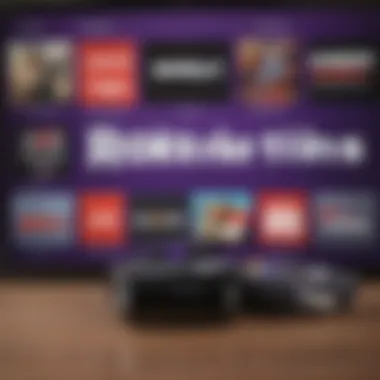Understanding the Costs of The Roku Channel: A Comprehensive Overview


Intro
The Roku Channel has become a notable player in the streaming industry, capturing the attention of a diverse audience. Understanding the costs associated with this platform is vital for consumers. Many users look for either free, ad-supported content or subscription models that can limit advertising interruptions. As importance of streaming services grows, so does the need for clarity in costs. This article delves into key elements that influence the financial aspect of The Roku Channel, allowing users to navigate their options with confidence.
Market Overview
The streaming market is highly competitive, and understanding its dynamics is essential for users.
Current Market Sentiment
Opinions on the current market for streaming services vary widely. Many view platforms like The Roku Channel favorably due to the flexibility they offer. The increasing preference for on-demand content signals a shift from traditional cable subscriptions toward streaming. However, economic factors also play a role. Consumers are becoming more cautious about their spending habits, leading to increased scrutiny of the value each service provides.
Major Indices Performance
Stock performance of major streaming companies can give some insight into market stability. Companies like Netflix and Disney+, as well as Roku, Inc., fluctuate based on subscriber numbers and revenue growth. Investors often consider how these companies respond to competitive pressures, which ultimately impacts the offerings that platforms like The Roku Channel provide.
Economic Indicators Analysis
Indicators like subscriber growth rates and advertising revenue are valuable metrics to assess the performance of The Roku Channel in the marketplace. For instance, rising costs of living may pressure consumers to prioritize value when selecting streaming options. This behavior can lead to increased interest in services that offer free content alongside subscription plans.
Cost Structure of The Roku Channel
Understanding the various costs involved allows for better financial decision-making. This section will explore different components that define financial engagement with The Roku Channel.
Accessing Free Content
One of the notable features is the availability of free content. The Roku Channel offers users access to a variety of movies and shows at no cost. However, this is supported by advertisements. This model allows users to consume content without a direct financial investment, appealing to budget-conscious consumers.
Subscription Options
For those who prefer fewer interruptions, Roku also offers premium subscriptions. Services like HBO Max, Showtime, and Starz are available through The Roku Channel. The costs of these subscriptions can vary significantly, depending on the service chosen. Users must consider if the benefits justify the cost.
Advertising Dynamics
Advertising plays a crucial role in the financial viability of The Roku Channel. While free content is appealing, it is essential for users to recognize that ad-supported models generate revenue. This revenue supports the operation and expansion of content offerings, directly impacting the user experience.
Hidden Fees
Some users may not be aware of potential hidden fees when using The Roku Channel. These can include additional costs for specific premium channels or features. It's important to read the terms of service and remain vigilant about any unforeseen charges.
Understanding the full landscape of costs can lead to more informed decisions, ensuring users choose the streaming service that best fits their preferences and budget.
Finale
Roku Channel's financial framework encompasses various elements. From free access to subscription services, each component plays a distinct role in shaping the costs involved. As users become savvier about their streaming choices, clarity in fees and offerings becomes increasingly important. The need for awareness regarding advertising and hidden costs cannot be overstated, as it greatly influences overall satisfaction with the service.
Prologue to The Roku Channel
The Roku Channel has emerged as a prominent player in the streaming landscape, gaining attention for both its free content and its subscription offerings. Understanding this channel is crucial for users who wish to navigate the complex world of online streaming. This article sheds light on various aspects that influence the costs associated with The Roku Channel.
What makes The Roku Channel particularly significant is its dual model of delivering content. Users can access a range of free programming, supported by advertisements, while also having the option to subscribe for additional premium content. This flexibility allows consumers to customize their viewing experiences based on their financial preferences and content desires.
Another important element to consider is the increasing competition in the streaming sector. As many platforms vie for viewer attention, understanding the pricing structure of The Roku Channel not only addresses its value proposition but also enables comparisons with rival streaming services.
To summarize, the importance of this section lies in highlighting the multifaceted structure of The Roku Channel and its implications for viewers. By grasping its operational framework and cost considerations, users can better navigate their streaming choices and make informed decisions aligned with their entertainment needs.
Overview of Roku Devices


Roku devices serve as the foundational hardware for accessing The Roku Channel and a variety of other streaming services. Understanding these devices is important as they greatly influence the user experience and overall costs associated with streaming. Roku provides an array of devices, catering to different needs and preferences, which can impact your viewing options and expenses.
Key Elements of Roku Devices
- Affordability: Roku devices are generally known for their reasonable price points. This can make them a suitable choice for budget-conscious consumers.
- Compatibility: Most Roku devices are compatible with numerous streaming services, enhancing their versatility. This allows users to access a wide range of content without being tied to a specific service.
- User-Friendliness: The interface and remote for Roku devices are designed for easy navigation, making streaming more accessible to users of varying technical skills.
- Performance: Depending on the device you choose, the speed and quality of streaming may vary. Higher-end models might support 4K and HDR streaming, which adds another layer of value.
When considering The Roku Channel, knowing which device to use, and the associated costs for that device, can help users make informed decisions. While the device is just one part of the streaming equation, it is a critical factor in determining overall satisfaction.
Types of Roku Devices
Roku offers a diverse selection of devices, each tailored to different consumer needs:
- Roku Express: An entry-level option, ideal for those new to streaming. It provides a straightforward way to access The Roku Channel and other services.
- Roku Streaming Stick+: This portable device provides robust performance and supports 4K and HDR. It is beneficial for users who want a more premium viewing experience.
- Roku Ultra: This is the top-tier device in terms of features. It includes advanced streaming options, faster performance, and a voice remote. It's suitable for users who prioritize streaming quality.
- Roku TV: Integrated directly into television sets, Roku TV simplifies the streaming experience by bundling features all in one device.
Setting Up Your Roku Device
The setup process for a Roku device is designed to be user-friendly, ensuring that anyone can begin watching their favorite shows quickly and easily. The steps to set up a Roku device typically include:
- Connect the Device: Plug your Roku device into an HDMI port on your TV. Ensure it is powered with the included adapter.
- Select the Input Source: Use your TV remote to select the HDMI input where your Roku is connected.
- Follow On-Screen Instructions: A series of prompts will guide you through the setup process. This often includes connecting to Wi-Fi and activating your device with a code.
- Roku Account Creation: If you do not have a Roku account, you will need to create one. This process is streamlined, requiring only basic information such as your email.
Understanding the setup process ensures a smooth start to utilizing The Roku Channel and adds to the overall streaming experience.
In essence, learning about Roku devices and their setup empowers users with the knowledge necessary to enjoy a seamless streaming experience.
Cost Structure of The Roku Channel
Understanding the cost structure of The Roku Channel is vital for both potential and existing users. The channel’s financial framework encompasses a mix of subscription models, advertising revenue streams, and various hidden costs. Each of these elements contributes significantly to the viewer’s overall experience and budget. This section elucidates these components, providing insights into how they work together to create the Roku ecosystem.
Subscription Models
For free content
Free content is a paramount aspect of The Roku Channel. It acts as a gateway for users to access a myriad of shows and films without the burden of subscription fees. The key characteristic of free content is that it allows viewers to enjoy entertainment without any financial commitment. Such a model is very appealing at a time when consumer habits tilt towards more cost-effective entertainment solutions.
A unique feature of free content on Roku is the availability of on-demand viewing paired with ads. This benefits the platform by generating advertising revenue while still providing no-cost access to users. However, it also means that the viewing experience can be interrupted by commercial breaks, which may deter some viewers. Thus, while it is a popular choice, the trade-off is the presence of advertisements.
Premium subscriptions
Turning to premium subscriptions, this option caters to users who seek an ad-free experience or who want access to exclusive and high-quality content. One key characteristic of premium subscriptions is that they offer a wider selection of movies and series, often including original productions. This signing up for a plan can be seen as a beneficial choice for those who prioritize content variety and quality over cost.
A notable feature of Roku’s premium subscriptions is their flexible pricing strategies. Subscriptions like Hulu + Live TV and Showtime can be included, which elevates the content libraries for users. However, premium subscriptions come with a recurring cost, setting up an expectation for users that may not be feasible for everyone. They should consider how often they will actually use the service to decide if the investment is worthwhile.
Advertising Revenue
The role of advertising revenue in the cost structure of The Roku Channel cannot be overstated. This revenue is generated primarily from the free content model and provides the financial backbone for the platform. Through strategically placed ads within programming, Roku maximizes its earnings while still delivering content to users. This model keeps the platform financially robust while ensuring that consumers have access to a multitude of viewing options without upfront costs. Though the presence of ads can sometimes detract from the viewing experience, many users accept it as a standard trade-off for free access.
Hidden Fees and Additional Costs
The hidden fees associated with The Roku Channel can impact overall user satisfaction. These costs can arise in several forms, primarily through channel add-ons and content purchases.
Channel add-ons
Channel add-ons can enhance the user experience but also introduce unexpected costs. Each additional channel usually functions on its own subscription or pay-per-view basis, creating a layered payment structure. This characteristic makes channel add-ons a popular choice for users who wish to customize their viewing experience based on personal preferences. Yet, this can lead to increased monthly expenses that users might not initially anticipate.
A distinctive aspect of channel add-ons is the variety of options available. While some channels focus on niche content, others may offer more mainstream selections. The downside, however, is that users must manage these multiple subscriptions, which can complicate budgeting and viewing habits.
Purchasing content


The ability to purchase content directly through The Roku Channel is another component contributing to hidden costs. While many viewers appreciate the flexibility of buying movies or series they want to watch, this practice can lead to unexpectedly high expenses when indulging in multiple purchases. Purchasing content gives viewers access to a temporary library of blockbuster hits without a long-term commitment.
Nonetheless, the key characteristic of purchasing content is that it can sometimes feel like an alluring trap for eager viewers. Without watching budgets in check, it can result in impulsive spending, which some may find to be a disadvantage to their overall viewing experience. Therefore, understanding these additional costs is crucial for users aiming to maximize their value while enjoying The Roku Channel.
Comparison with Other Streaming Services
In discussing the costs of The Roku Channel, comparing it with other streaming services provides essential insights into its value proposition. Such comparisons highlight unique aspects of Roku, helping consumers understand their choices in a crowded market of streaming options.
When analyzing streaming services like Disney+, Netflix, and Amazon Prime Video, various factors become apparent. First, the subscription structure offers diverse pricing, content availability, and viewing experiences are critical when determining which service best fits a consumer's needs. Each service has its advantages and disadvantages, which should be considered in relation to The Roku Channel's offerings.
Disney+
Disney+ has gained significant traction due to its extensive catalog of beloved franchises. Subscribers have access to a mix of classic films, animated features, and original series. This platform focuses primarily on family-friendly content, which can be a major draw for parents.
In terms of cost, Disney+ generally requires a monthly fee, with options for annual subscriptions as well. The standard monthly plan tends to be competitively priced, making it attractive compared to The Roku Channel's free offerings, though Roku's ad-supported content may introduce viewers to newer titles they wouldn't explore on a subscription-only service.
A downside of Disney+ includes the lack of a free tier. Viewers must pay to access content, contrasting with The Roku Channel’s free options.
Netflix
Netflix remains a dominant player in the streaming industry. It offers a vast library across genres, alongside acclaimed original programming. This platform does not include ads in its standard models, which provides an uninterrupted viewing experience.
However, Netflix's cost structure typically comes with higher subscription fees. These fees are justified by its exclusive content, including series that have won numerous awards. Nevertheless, for those seeking cost-effective solutions—especially free ones—The Roku Channel presents an appealing alternative, especially for viewers who are not in pursuit of Netflix's specific offerings.
The evolving nature of Netflix, such as introducing a cheaper ad-supported tier, has stirred discussions about subscription models and financial strategies that consumers should keep in mind.
Amazon Prime Video
Amazon Prime Video is bundled into the overall Amazon Prime membership. It provides not only streaming services but also benefits related to shopping, such as free shipping. The dual-purpose model adds value but presents complexity regarding the actual cost of video content compared to stand-alone services like The Roku Channel.
While Amazon Prime Video has a vast selection, its pricing model can be confusing. Subscribers pay for the Amazon Prime membership, which includes many features beyond streaming, further complicating direct cost comparisons. The ability to rent or purchase certain titles also leads to additional expenses, an area where The Roku Channel offers a simplified approach with its ad-supported model.
Overall, comparing these services with The Roku Channel reveals distinct market positions. Each of these platforms has unique advantages that may appeal to different consumer needs, empowering consumers to make informed decisions about their streaming options. Understanding these nuances can be crucial when evaluating the overall value of The Roku Channel amid the competitive landscape of streaming services.
Content Quality and Availability
Understanding the content quality and availability on The Roku Channel is crucial to evaluating its value to users. Content quality ensures that viewers have access to programs that are engaging and well-produced, while availability pertains to how easily users can access these offerings. Given the competitive landscape of streaming services, the balance between these two factors can dictate user satisfaction and retention.
Quality content frequently attracts more viewers. Consumers often seek programming that either entertains or informs. This could range from high-budget original series to carefully curated documentaries. Roku’s Original Programming represents this dimension, potentially influencing consumer choice over alternative services.
Additionally, availability is key. Users place higher value on a service that offers content they can watch on demand, anytime. If users discover that their preferred shows are available through The Roku Channel, they may be more inclined to explore other Roku offerings or even rely on the platform as their primary source for entertainment.
Another point worth noting involves geographic restrictions. Some content may not always be available in every region. Understanding these limitations helps consumers manage their expectations. Viewing choices may differ based on where the user is located.
In summary, the interplay of content quality and availability on The Roku Channel is significant for informed streaming choices. Consumers benefit from being aware of these aspects, leading to a more satisfying viewing experience.
Original Programming
The Roku Channel has increasingly invested in original programming, aiming to compete with established platforms like Disney+ or Netflix. These original shows are designed with diverse audiences in mind, catering to various tastes and preferences.
Roku's strategic decision to create original content allows them to build a unique space in the crowded content landscape. This distinctiveness enhances the dive into new genres and storytelling methods that might appeal to niche audiences, something that many competing platforms have also done.
However, the true test of success lies in viewer reception. Shows that capture audience interest can drive subscriptions and enhance advertising revenue. Thus, content quality becomes increasingly important when evaluating the overall experience.
Some popular series have made waves within the streaming landscape and helped in boosting the channel's profile. Understanding the reception of these shows, through metrics like viewer ratings or comment sections, can provide insights into what works and what doesn't.
Third-Party Content


In addition to original shows, The Roku Channel also features an array of third-party content. This variety caters to a broader audience by making popular films and series accessible in one aggregated location. The combination of Roku's original programming with third-party offerings can create a compelling content library.
Licensing agreements with various networks and production companies enrich the viewer's experience. For consumers, this means more choices. They can explore genres that may not be present in original programming. Furthermore, a broader selection often leads to increased user engagement.
That said, the presence of third-party content can raise questions regarding quality. The consistency of third-party productions may vary, which could affect the channels’ overall reputation. Quality assessments from sources like viewer ratings or expert reviews could help mitigate concerns.
Target Audience and Consumer Insights
Understanding the target audience for The Roku Channel is vital for several reasons. First, it helps in tailoring the content to meet diverse viewer needs. This can lead to higher satisfaction levels among users, increasing overall viewership. Second, insights into consumer behavior can provide valuable data for advertisers looking to reach their desired demographics. By comprehending whom they are targeting, they can optimize their marketing strategies accordingly.
Moreover, in a competitive streaming environment, knowing the audience influences how The Roku Channel positions itself in the marketplace. It is essential to identify specific trends, preferences, and demographics that characterize Roku's viewership.
Demographics
Demographics provide a statistical foundation to understand who watches The Roku Channel. This includes age, gender, income levels, and geographic locations. Research indicates that Roku users tend to be diverse. For instance, younger audiences, particularly those below 35 years old, are more inclined toward streaming services. They often prefer on-demand content over traditional cable. In contrast, viewers in older generations may still have some preference for conventional broadcast.
Additional demographic factors include income levels, often correlating with the likelihood to subscribe to premium content. Lower-income households may predominantly engage with free content and may be more sensitive to advertisements.
User Preferences
User preferences encompass a range of factors that influence how viewers consume content on The Roku Channel. This includes content types, viewing habits, and ad tolerance. Many users prefer diverse genres such as comedy, drama, and documentaries. They typically seek high-quality content that resonates with their interests.
Viewing habits also play a crucial role. For example, binge-watching behaviors are common, particularly among younger audiences. This trend suggests that users may lean towards series with multiple episodes rather than standalone movies.
Moreover, understanding ad tolerance is critical. Users who prefer free content often encounter more advertisements. They may have a higher tolerance if the content value is perceived as high. Conversely, those paying for subscriptions expect fewer ads, which can affect their overall satisfaction with the service.
Insights into user preferences help shape content acquisition and marketing strategies. This allows The Roku Channel to cater to its audience more effectively, enhancing user experience and retention.
Future Trends for The Roku Channel
Future trends in streaming services like The Roku Channel are critical to understand. Providers must adapt to changing consumer demands and technological advancements. This section focuses on the elements that will shape the future of The Roku Channel, covering both innovations and market dynamics.
Technological Innovations
Technological innovations play a vital role in enhancing user experience and expanding The Roku Channel's reach. As streaming technology evolves, Roku is positioned to integrate new features that cater to user preferences. Some of the key advancements expected include:
- Enhanced User Interface: Streamlined design will make navigation simpler and more intuitive for users.
- Improved Streaming Quality: Advances in video encoding technology, such as AV1, will improve streaming quality and reduce buffering.
- AI Recommendations: The use of artificial intelligence to analyze viewing habits can lead to more tailored recommendations for users, increasing viewer engagement.
The success of streaming platforms hinges on their ability to innovate and stay relevant in a fast-paced market.
Furthermore, developments in 5G technology may also enhance mobile streaming, providing more flexibility for users who prefer to watch on the go. Roku may tap into this potential, expanding its audience and increasing overall viewership.
Market Positioning
The Roku Channel's position in the market is vital. With numerous competitors, Roku must find ways to differentiate itself. Strong positioning can lead to increased market share and user loyalty.
To maintain competitive advantage, The Roku Channel might focus on:
- Content Partnerships: Collaborations with premium content providers can enhance programming diversity.
- Aggressive Pricing Strategies: Attractive pricing models may draw in more users. Free content provisions will likely continue playing a significant role.
- Community Engagement: Building a community through forums and social media could foster a loyal viewer base. Engaging audiences on platforms like Reddit or Facebook may enable direct feedback and foster improvements based on user suggestions.
As a result, positioning Roku as a user-friendly platform with diverse content could increase its relevance in an already crowded market. Understanding these trends is essential for potential investors and current users alike when considering The Roku Channel as a key part of their streaming strategy.
Finale
In summarizing the costs associated with The Roku Channel, it is crucial to understand the multifaceted nature of its offerings. The Roku Channel presents various financial aspects that merit attention. While some features are free, enhancements available through premium subscriptions and channel add-ons can lead to unexpected expenditures.
Understanding the balance between free content and what may be seen as hidden fees allows for a clearer financial picture. A consumer's choice of subscription model must align with their viewing habits. Thus, discerning which premium offerings are worth the price adds significant value to their streaming experience.
Additionally, comparing The Roku Channel with competitors like Disney+, Netflix, and Amazon Prime Video helps in gauging its overall value proposition. Each service presents unique merits, and a consumer’s priorities should heavily influence their decisions.
Ultimately, a thorough grasp of these components aids in making informed choices regarding streaming services. By examining the cost structures, one can optimize their viewing experience and ensure they are making the most of their investment in entertainment.
Effective financial planning in streaming services enhances not only the content quality one experiences but also maximizes the value derived from subscriptions.



